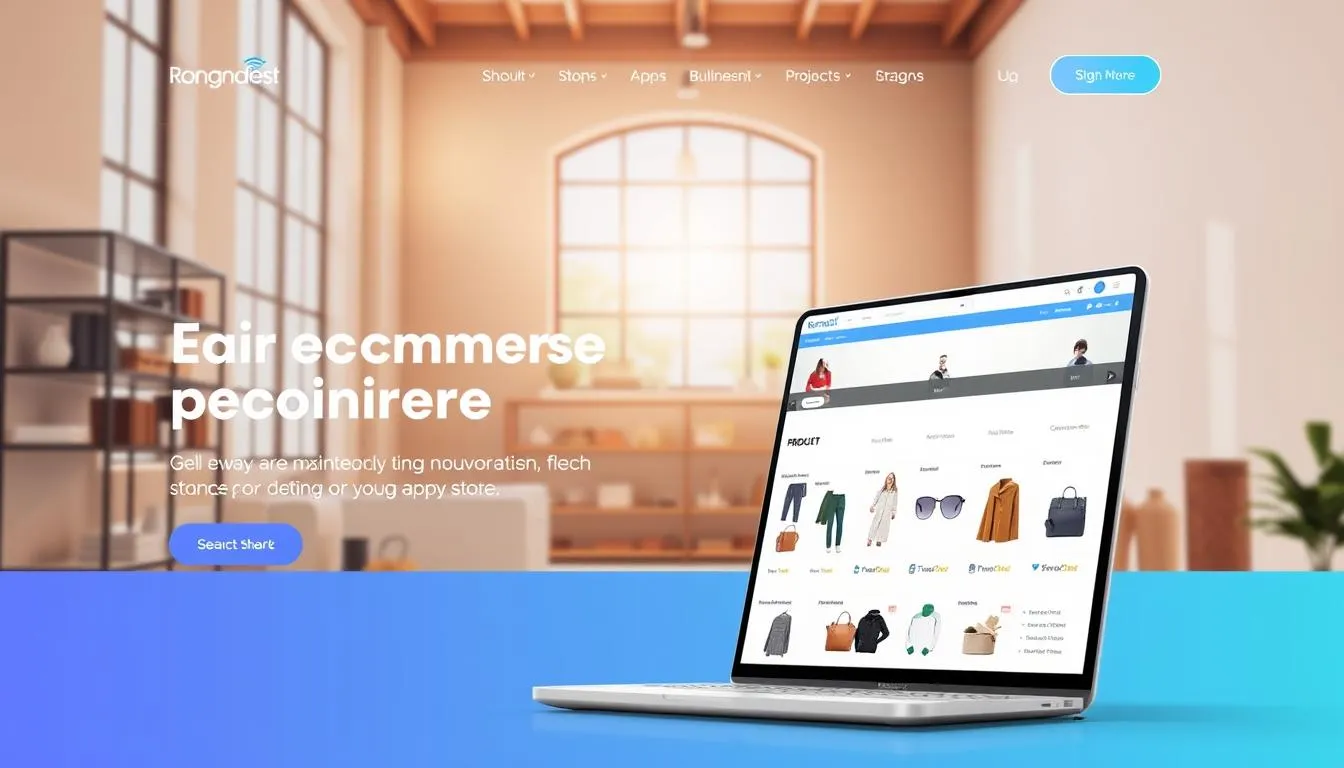Last Updated on: June 19, 2025
Crafting a successful e-commerce website requires a deep understanding of both your target audience and the latest web design trends. A well-designed online store not only attracts visitors but also keeps them engaged, encouraging them to make a purchase.
A user-friendly online store design is crucial for maximizing sales. By balancing aesthetics with functionality, you can create an e-commerce website that is both visually appealing and highly functional.
Conversion rate optimization is also vital to ensure that your online store is converting visitors into customers.
Key Takeaways
- Understand your target audience and the latest web design trends.
- Balance aesthetics with functionality in your online store design.
- Optimize your e-commerce website for conversion rate optimization.
- Create a user-friendly online store that is visually appealing.
- Maximize sales by crafting a successful e-commerce website.
Understanding E-commerce Website Fundamentals
Building a successful e-commerce website requires a deep understanding of its fundamental elements. A well-structured online store is crucial for providing a seamless user experience and driving sales.
Key Components of Successful Online Stores
Successful online stores share certain key components that contribute to their effectiveness. These include essential pages and features, as well as technical requirements that ensure a smooth user experience.
Essential Pages and Features
Essential pages such as product categories, product details, and checkout pages are vital. Features like search functionality, product reviews, and responsive design also play a crucial role.
Technical Requirements
Technical requirements include fast loading speeds, secure payment gateways, and mobile responsiveness. These elements are critical for ensuring a seamless and secure shopping experience.
Identifying Your Target Audience and Their Needs
Understanding your target audience is vital for creating an e-commerce website that meets their needs. This involves conducting market research and creating buyer personas.
Market Research Techniques
Market research techniques include surveys, customer interviews, and analyzing competitors. These methods help identify trends and preferences.
Creating Buyer Personas
Creating detailed buyer personas helps in understanding customer behavior, preferences, and pain points. This information is crucial for tailoring the website to meet customer needs.
By understanding these fundamentals, businesses can create e-commerce websites that are both user-friendly and effective at driving sales.
How to Design an E-commerce Website for Better Sales?
Designing an e-commerce website that drives sales requires a thoughtful approach to both aesthetics and functionality. A well-crafted website must balance visual appeal with usability to create a seamless user experience.
Design Principles That Drive Conversions
Effective e-commerce design is guided by principles that enhance user engagement and conversion. Two crucial elements are color psychology and brand consistency, and visual hierarchy and call-to-action placement.
Color Psychology and Brand Consistency
The strategic use of colors can significantly impact consumer behavior. Brands must choose a color scheme that resonates with their target audience and maintains consistency across the website. For instance, a brand that wants to convey a sense of urgency might use red for call-to-action buttons.
Visual Hierarchy and Call-to-Action Placement
A clear visual hierarchy guides the user’s attention to key elements on the page, such as call-to-action buttons. Strategic placement of these elements can improve conversion rates by making it easier for users to navigate the site and complete desired actions.
Balancing Aesthetics and Functionality
Balancing aesthetics with functionality is crucial for e-commerce success. This involves implementing speed optimization techniques to ensure fast loading times and adopting minimalist design approaches to enhance usability.
Speed Optimization Techniques
Optimizing images, leveraging browser caching, and minimizing HTTP requests are effective techniques for improving website speed. A faster website not only improves user experience but also positively impacts search engine rankings.
Minimalist Design Approaches
A minimalist design focuses on essential elements, reducing clutter and improving navigation. This approach can lead to higher conversion rates by making it easier for users to find what they’re looking for.
By incorporating these design principles and balancing aesthetics with functionality, e-commerce businesses can create websites that drive sales and enhance the overall user experience.
Creating an Intuitive User Experience
An intuitive user experience is the backbone of a successful e-commerce website, directly influencing customer satisfaction and conversion rates. A well-designed website enables users to effortlessly navigate through products, find what they’re looking for, and complete their purchases without unnecessary hurdles.
Streamlining Navigation and Site Structure
A streamlined navigation and site structure are crucial for helping users quickly locate products. This involves organizing categories in a logical manner, using clear and concise labels, and minimizing the number of clicks required to reach product pages.
Implementing Search Functionality That Converts
Effective search functionality is vital for users who know exactly what they’re looking for. Implementing features like autocomplete, synonyms recognition, and filtering options can significantly enhance the search experience, leading to higher conversion rates.
Designing Category Pages That Engage
Category pages should be designed to engage users and encourage them to explore further. This can be achieved by including high-quality product images, clear product information, and intuitive filtering and sorting options, making it easier for users to find their desired products.
By focusing on these key areas, e-commerce businesses can create an intuitive user experience that not only attracts customers but also retains them, driving sales and fostering loyalty.
Optimizing Product Pages for Conversions
Optimizing product pages is a critical step in enhancing the overall e-commerce experience and driving sales. A well-optimized product page can significantly improve conversion rates by providing customers with the information they need to make a purchasing decision.
Crafting Compelling Product Descriptions
Effective product descriptions are crucial for converting visitors into buyers. They should be SEO-friendly and focused on the benefits to the customer.
SEO-Friendly Content Strategies
To optimize product descriptions for search engines, incorporate relevant keywords naturally. This involves understanding the search terms your target audience uses and integrating them into your content.
Benefit-Focused Copywriting
Instead of just listing product features, benefit-focused copywriting highlights how those features will benefit the customer. This approach helps customers envision how the product will solve their problems or improve their lives.
Using High-Quality Images and Videos
High-quality images and videos are essential for showcasing products in the best possible light. They help build trust with potential customers and can significantly enhance the user experience.
Product Photography Best Practices
Good product photography involves using high-resolution images, proper lighting, and multiple angles to give customers a comprehensive view of the product.
Interactive Elements and 360° Views
Incorporating interactive elements like 360° views allows customers to engage more deeply with the product, improving their understanding and confidence in their purchasing decision.
Implementing Social Proof and Reviews
Social proof, such as customer reviews, plays a vital role in building trust with potential customers. It provides reassurance that other customers have had positive experiences with the product.
Customer Review Systems
Implementing a customer review system allows customers to share their experiences, providing valuable feedback and helping to build credibility for your products.
User-Generated Content Integration
Integrating user-generated content, such as customer photos or videos, can further enhance social proof. It shows that real customers are using and benefiting from your products.
By focusing on these key areas, e-commerce businesses can optimize their product pages to drive conversions and improve customer satisfaction.
Streamlining the Checkout Process
Streamlining the checkout process can significantly reduce cart abandonment rates, ensuring that visitors complete their purchases. A simplified checkout experience not only enhances customer satisfaction but also encourages repeat business.
Reducing Cart Abandonment Rates
Cart abandonment is a significant issue for e-commerce businesses. To mitigate this, it’s essential to minimize the steps required to complete a purchase. Simplifying forms and reducing the number of pages in the checkout process can make a substantial difference. According to a study, a complicated checkout process is one of the top reasons for cart abandonment.
Offering Multiple Payment Options
Catering to different customer preferences by offering multiple payment options can enhance the checkout experience. This includes credit cards, PayPal, and other digital payment methods. By providing a variety of payment choices, businesses can reduce friction and make it more likely for customers to complete their purchases.
Creating Guest Checkout Options
Forcing customers to create an account can be a barrier to purchase. Creating guest checkout options removes this barrier, allowing customers to checkout quickly and easily. As noted by a retail expert, “Guest checkout can significantly improve conversion rates by reducing friction at the point of sale.”
“The key to a successful checkout process is simplicity and flexibility.”
By implementing these strategies, e-commerce businesses can streamline their checkout process, reduce cart abandonment, and ultimately increase sales.
Mobile Optimization Strategies
With the majority of online shoppers using mobile devices, a mobile-optimized e-commerce site is essential. Ensuring that your website is accessible and user-friendly on smaller screens can significantly impact your sales and customer satisfaction.
Responsive Design Best Practices
Adopting responsive design is the first step towards mobile optimization. This involves creating a website that automatically adjusts its layout and content to fit different screen sizes. Responsive design is not just about aesthetics; it’s also about ensuring that your site’s functionality is preserved across devices.
Touch-Friendly Interface Elements
A touch-friendly interface is crucial for a good mobile user experience. This means using large buttons, simple menus, and ensuring that interactive elements are easy to tap. By doing so, you reduce the frustration that can lead to cart abandonment.
Simplified Navigation for Mobile Users
Simplifying navigation for mobile users involves streamlining menus and reducing the number of steps to checkout. A straightforward and intuitive navigation system can significantly enhance the mobile shopping experience.
Mobile-Specific Features That Boost Sales
Beyond responsive design, there are several mobile-specific features that can boost sales. These include mobile payment solutions and app-like experiences through progressive web apps.
Mobile Payment Solutions
Mobile payment solutions like Apple Pay, Google Pay, and Samsung Pay offer customers a quick and secure way to pay, reducing cart abandonment rates. Integrating these solutions can enhance the checkout experience.
App-Like Experiences with Progressive Web Apps
Progressive Web Apps (PWAs) provide an app-like experience without the need for users to download an app. PWAs offer offline capabilities, push notifications, and a native app-like experience, significantly enhancing user engagement.
By implementing these mobile optimization strategies, e-commerce businesses can provide a seamless and engaging shopping experience, driving sales and customer loyalty.
Implementing Trust Signals and Security Features
Trust signals and security features play a vital role in reassuring customers and reducing cart abandonment rates. By visibly showcasing the security measures in place, e-commerce businesses can build credibility and foster a trustworthy environment for their customers.
Security Badges and Certifications
Displaying security badges and certifications is a straightforward way to communicate to customers that their data is protected. These badges serve as visual cues that can significantly enhance the perceived trustworthiness of an e-commerce site.
SSL Certificates and HTTPS Implementation
One of the most critical trust signals is the implementation of SSL certificates and HTTPS. This not only secures the data transmitted between the customer’s browser and the server but also signals to search engines that the site is secure, potentially improving search rankings.
Payment Security Indicators
Displaying payment security indicators, such as those provided by Visa or Mastercard, can further reassure customers about the security of their transactions. These indicators are recognized globally and can significantly reduce concerns about data breaches.
Clear Policies and Guarantees
Beyond technical security measures, having clear policies and guarantees in place is essential for building trust. This includes transparent return and refund policies, as well as a comprehensive privacy policy.
Return and Refund Policies
A clear return and refund policy helps alleviate the risk perceived by customers, making them more likely to complete a purchase. It’s essential to make this information easily accessible.
Privacy Policy and GDPR Compliance
Ensuring GDPR compliance and having a transparent privacy policy are crucial for maintaining customer trust. This involves being clear about how customer data is collected, used, and protected.
Leveraging Analytics for Continuous Improvement
Analytics play a vital role in the continuous improvement of e-commerce websites, enabling businesses to make data-driven decisions. By tracking key metrics and analyzing user behavior, businesses can identify areas for improvement and optimize their websites for maximum sales.
Essential Metrics to Track
To effectively leverage analytics, it’s crucial to track the right metrics. Two essential metrics for e-commerce businesses are conversion rate and customer lifetime value.
Conversion Rate Optimization
Conversion rate optimization involves analyzing and improving the percentage of website visitors who complete a desired action. By optimizing conversion rates, businesses can significantly boost sales.
Customer Lifetime Value Analysis
Customer lifetime value analysis helps businesses understand the total value of a customer over their lifetime. This metric is crucial for developing effective marketing strategies and improving customer retention.
A/B Testing for Conversion Optimization
A/B testing is a powerful tool for conversion optimization. It involves comparing two versions of a webpage to determine which one performs better.
Testing Methodology
A well-planned testing methodology is essential for effective A/B testing. This includes defining clear goals, selecting the right testing tools, and ensuring statistically significant results.
Key Elements to Test
Key elements to test include product pages, call-to-action buttons, and checkout processes. By testing these elements, businesses can identify areas for improvement and optimize their websites accordingly.
Using Heatmaps and User Recordings
Heatmaps and user recordings provide valuable insights into user behavior, helping businesses identify pain points and optimize the user experience.
Identifying User Pain Points
By analyzing heatmaps and user recordings, businesses can identify areas where users struggle or drop off. This information can be used to make targeted improvements.
Optimizing Based on User Behavior
Understanding user behavior is crucial for optimizing the user experience. By analyzing heatmaps and user recordings, businesses can make data-driven decisions to improve their websites.
Personalization and Advanced Marketing Features
Personalization is revolutionizing the e-commerce landscape by providing customers with tailored experiences that drive engagement and conversions. By leveraging advanced marketing features and personalization strategies, e-commerce businesses can significantly enhance customer satisfaction and loyalty.
One of the key personalization techniques is using product recommendations powered by AI. These recommendations help customers discover relevant products based on their browsing history and purchase behavior. This not only improves the shopping experience but also increases the average order value.
Product Recommendations and AI
AI-driven product recommendations analyze customer data to suggest products that are likely to interest them. This technology can be integrated into various parts of the e-commerce website, such as the homepage, product pages, and even in email marketing campaigns.
- Enhance customer experience with tailored product suggestions
- Increase average order value through strategic product recommendations
- Improve customer retention by providing relevant content
Email Marketing Integration and Automation
Email marketing remains a powerful tool for e-commerce businesses. By integrating email marketing automation, businesses can send personalized emails to customers based on their interactions with the website. This includes abandoned cart reminders, product recommendations, and special promotions.
Upselling and Cross-Selling Techniques
Upselling and cross-selling are effective strategies to increase revenue. By analyzing customer data and purchase history, businesses can identify opportunities to offer complementary products or premium versions of products customers are already purchasing.
- Use data analytics to identify upselling and cross-selling opportunities
- Train sales staff to effectively suggest additional products
- Implement personalized marketing campaigns to promote related products
Conclusion
Creating an e-commerce website that drives maximum sales requires a multifaceted approach. By understanding e-commerce fundamentals, designing for conversions, and leveraging analytics, you can create a sales-driven e-commerce website that attracts and retains customers.
Effective website optimization is crucial to achieving e-commerce success. This involves streamlining the checkout process, implementing trust signals, and personalizing the shopping experience. By incorporating these strategies, you can increase conversions and drive sales.
A sales-driven design is essential for capturing customers’ attention and guiding them through the buying process. By balancing aesthetics and functionality, you can create an intuitive user experience that fosters engagement and conversion.
Ultimately, achieving e-commerce success requires ongoing optimization and improvement. By continuously monitoring analytics and refining your strategies, you can stay ahead of the competition and drive long-term sales growth.
FAQ
What are the key elements of a successful e-commerce website?
A successful e-commerce website requires a combination of user experience, conversion rate optimization, and sales-driven design principles, including essential pages and features, technical requirements, and a seamless checkout process.
How do I identify my target audience for my e-commerce website?
Identifying your target audience involves conducting market research and creating buyer personas to understand their needs, preferences, and behaviors, allowing you to tailor your website and marketing strategies accordingly.
What design principles drive conversions on an e-commerce website?
Design principles that drive conversions include color psychology, brand consistency, visual hierarchy, and strategic call-to-action placement, as well as balancing aesthetics with functionality through speed optimization and minimalist design approaches.
How can I optimize my product pages for conversions?
Optimizing product pages involves crafting compelling product descriptions, using high-quality images and videos, and implementing social proof through customer review systems and user-generated content integration.
What are some strategies for streamlining the checkout process?
Streamlining the checkout process involves reducing cart abandonment rates by offering multiple payment options, creating guest checkout options, and simplifying the checkout process to make it as seamless and straightforward as possible.
Why is mobile optimization crucial for e-commerce websites?
Mobile optimization is crucial because the majority of online shoppers use mobile devices, and a non-mobile-friendly website can lead to a poor user experience and lost sales, making responsive design and mobile-specific features essential.
How can I implement trust signals and security features on my e-commerce website?
Implementing trust signals and security features involves displaying security badges and certifications, such as SSL certificates, and having clear policies and guarantees, including return and refund policies, and ensuring GDPR compliance.
What role does analytics play in e-commerce website optimization?
Analytics plays a crucial role in e-commerce website optimization by tracking essential metrics, such as conversion rates and customer lifetime value, and informing A/B testing, heatmaps, and user recordings to drive continuous improvement.
How can personalization enhance the shopping experience on my e-commerce website?
Personalization can enhance the shopping experience by using product recommendations powered by AI, integrating email marketing and automation, and implementing upselling and cross-selling techniques to offer customers relevant products and services.
What is the importance of A/B testing in conversion optimization?
A/B testing is important in conversion optimization as it allows you to test different elements of your website, such as product pages, checkout process, and marketing strategies, to identify what works best for your customers and drive improvements.




